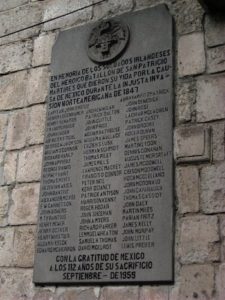
St. Patrick's Battalion Plaque,
San Angel District, Mexico City
*On this date from 1846, the African American Registry celebrates St. Patrick’s Day by honoring the Saint Patrick's Battalion. This unit of men personified 19th-century support for rightful intersectionality over race, class, and nationality in America and Mexico.
Also known as the Batallón de San Patricio, they fought in the Mexican American War. This unique fighting military regiment came into being on April 12, 1846. They were formed and led by Jon Riley, an Irish immigrant from Michigan who served in the British army throughout Canada. Saint Patrick's Battalion was a unit of 175 to several hundred immigrants (accounts vary) and expatriates of white-European descent who fought as part of the Mexican Army against the United States in the Mexican American War.
Most battalion members had deserted or defected from the United States Army for abolitionist (anti-Slavery) values and better (Land Grant) opportunities from Mexico. Comprised primarily of Catholic Irish immigrants, the Battalion included Canadians, English, French, Germans, Italians, Poles, Scots, Spaniards, Swiss, and Mexicans, most of whom were members of the Catholic Church. Disenfranchised Americans were in the ranks, including escaped slaves from the Southern United States.
The Mexican government offered incentives to foreigners who would enlist in its army: granting them citizenship, paying higher wages than the U.S. Army, and offering generous land grants. Only a few members of the Saint Patrick's Battalion were U.S. citizens known to have deserted from the U.S. Army. The Battalion served as an artillery unit for much of the war. It was later formally designated as infantry, but it retained artillery pieces throughout the conflict.
The Battalion acted as the sole Mexican counter-balance to U.S. horse artillery in many ways. For many Americans of the generation who fought the Mexican American War, the San Patricios were considered traitors. For Mexicans of that generation, Blacks, and generations to come, the San Patricios were heroes who fought against Slavery and went to the aid of those in need.
Most of these men were recent immigrants who had arrived at northeastern U.S. ports, part of the Irish Diaspora, then escaping the Great Irish Famine and deplorable economic conditions in Ireland, part of the United Kingdom of Great Britain and Ireland at the time. Some historians believed a primary motivation was shared religion with the Mexicans, sympathy for the Mexican cause, and the American desire to the expansion of Slavery. This hypothesis is based on evidence of the number of Irish Catholics in the Battalion, Jon Riley's letters, and senior officers' field entries.
Despite early American popularity at home, the war was marked by the growth of a loud anti-war movement that included Americans Ralph Waldo Emerson, former president John Quincy Adams, and Henry David Thoreau. The center of anti-war sentiment gravitated around New England and was directly connected to the movement to abolish Slavery. Texas became a slave state upon entry into the Union. In September 1847, the U.S. Army hanged sixteen surviving Batallón de San Patricio members as traitors. To this day, they are considered heroes in Mexico.